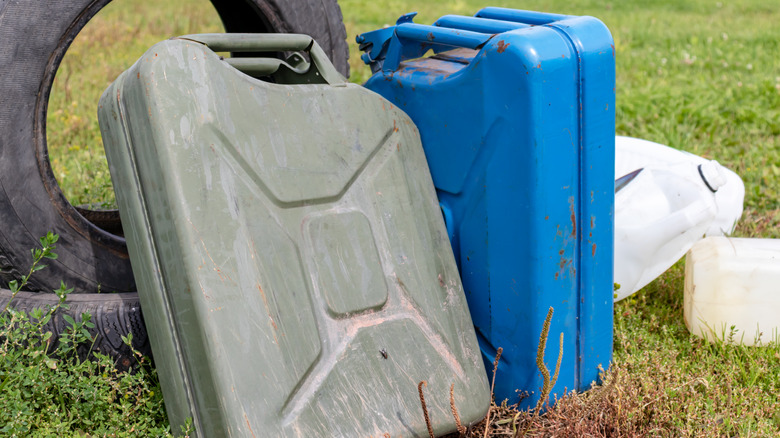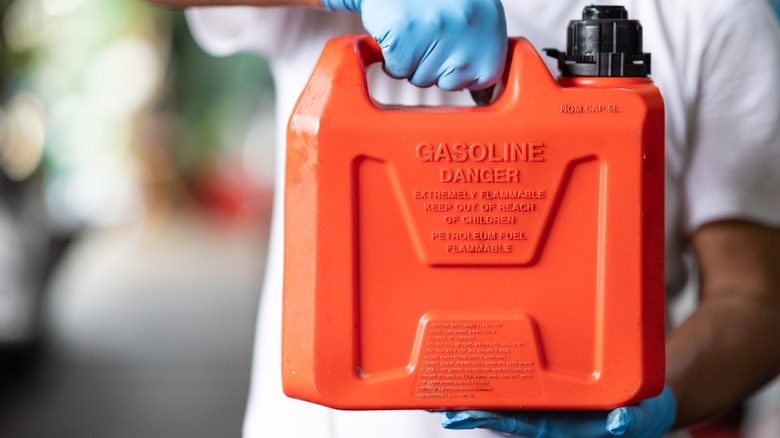How To Properly Dispose Of Gasoline
Many people might be under the impression that gasoline never goes bad or expires. However, that simply isn't true, because if fuel goes unused for a substantial amount of time, it will begin to degrade and can eventually become less of a helpful fuel for your vehicle and more of a pollutant that can cause more harm than good. Beyond that, it doesn't last as long as you might expect.
According to the experts, gasoline has a shelf life of just three to six months, and using any that has been stored away for longer than that could run the risk of doing damage to whatever it's being used with or affecting the performance down the road, which is why it's important to identify any warning signs that it's time take out the gas.
Ensuring that this is done the right way is incredibly important, not just for environmental protection but for your personal safety as well. This highly flammable liquid can be quite dangerous due to its volatility, and it must be handled with extreme care no matter what the circumstances may be. When it is not discarded in the correct manner, the substance can cause significant harm to the environment by contaminating the soil and water. Given the number of potential risks involved, it is absolutely crucial for everyone to have a comprehensive understanding of the appropriate methods of gasoline disposal.
How to dispose gasoline properly
Pouring the remaining contents of the tank down the drain or into the sewer is not a viable option. Putting it next to the garbage bags on the curb when trash day comes along isn't going to cut it either. Finally, leaving it out to be evaporated as a possible solution will not work either. Here is what you need to do to properly dispose of gasoline.
- Carefully transfer the gasoline into a government-approved container.
- Any spills should be cleaned up immediately and any liquid on the outside of the container should be wiped off right away.
- Locate the nearest hazardous waste disposal site by contacting the local waste management.
- Once the disposal site has been verified, transport the gasoline to the location safely.
- At the designated facility, make sure to follow whatever process they have in play and dispose of the gasoline.
While the process may not be the quickest or easiest of endeavors when it comes to waste removal, the undeniable benefits of disposing of gasoline through the proper channels make the extra effort well worth it. Those who want to make certain that any petrol they have stored or come in contact with hasn't spoiled should familiarize themselves with what to look for, which may imply the necessity of putting these steps into action.
How to tell if gasoline is ready for disposal
Determining whether gasoline has significantly deteriorated involves a few key observations. The easiest way to tell if gas has gone bad is to use your nose, as old gas has a distinct change in smell. Fresh fuel from the pump has a noticeably recognizable scent that you are likely familiar with, but when it ages and becomes contaminated, it undergoes chemical changes that emit a rather unpleasant aroma.
However, there are also plenty of visual cues. Fresh gasoline typically appears clear with a faint yellow tint. However, as time passes, its appearance goes through a noticeable transformation that causes the fuel to darken, transitioning from its initial state to a brownish-tan color. The transparency of the fuel will also begin to fade, resulting in the substance looking stale and very hazy. In addition, the presence of water, often indicated by separation or cloudy appearance, confirms that the fuel has degraded and is no longer suitable for use.
In any of these cases, the proper steps need to be taken to dispose of the gas safely to avoid potential hazards and environmental damage.


